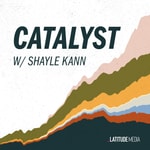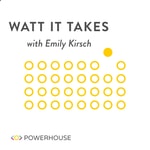Catalyst with Shayle Kann – Détails, épisodes et analyse
Détails du podcast
Informations techniques et générales issues du flux RSS du podcast.

Catalyst with Shayle Kann
Latitude Media
Fréquence : 1 épisode/7j. Total Éps: 206

Classements récents
Dernières positions dans les classements Apple Podcasts et Spotify.
Apple Podcasts
🇺🇸 États-Unis - technology
28/07/2025#18🇨🇦 Canada - technology
27/07/2025#71🇺🇸 États-Unis - technology
27/07/2025#19🇨🇦 Canada - technology
26/07/2025#47🇩🇪 Allemagne - technology
26/07/2025#84🇺🇸 États-Unis - technology
26/07/2025#25🇨🇦 Canada - technology
25/07/2025#65🇺🇸 États-Unis - technology
25/07/2025#64🇺🇸 États-Unis - technology
24/07/2025#89🇬🇧 Grande Bretagne - technology
23/07/2025#69
Spotify
🇺🇸 États-Unis - technology
28/07/2025#36→🇺🇸 États-Unis - technology
27/07/2025#36↘🇺🇸 États-Unis - technology
26/07/2025#34↘🇺🇸 États-Unis - technology
25/07/2025#33→🇺🇸 États-Unis - technology
24/07/2025#33↗🇺🇸 États-Unis - technology
23/07/2025#34→🇺🇸 États-Unis - technology
22/07/2025#34→🇺🇸 États-Unis - technology
21/07/2025#34→🇺🇸 États-Unis - technology
20/07/2025#34→🇺🇸 États-Unis - technology
19/07/2025#34→
Liens partagés entre épisodes et podcasts
Liens présents dans les descriptions d'épisodes et autres podcasts les utilisant également.
See all- https://www.powerhouse.fund/subscribe.
13 partages
Qualité et score du flux RSS
Évaluation technique de la qualité et de la structure du flux RSS.
See allScore global : 58%
Historique des publications
Répartition mensuelle des publications d'épisodes au fil des années.
The rise of climate adaptation tech
jeudi 5 septembre 2024 • Durée 39:33
Why are we still flaring gas?
jeudi 29 août 2024 • Durée 33:39
Decarbonizing the high seas
vendredi 12 juillet 2024 • Durée 44:44
What’s holding up hydrogen in Europe?
jeudi 20 octobre 2022 • Durée 44:40
What climatetech can learn from the oceans
jeudi 13 octobre 2022 • Durée 38:03
How well does soil actually store carbon?
jeudi 6 octobre 2022 • Durée 36:25
Is the Inflation Reduction Act a win for EVs and batteries?
jeudi 29 septembre 2022 • Durée 46:39
Columbia Energy Exchange: Will Putin’s Energy Strategy Backfire?
jeudi 22 septembre 2022 • Durée 56:19
Averting water wars as we decarbonize
jeudi 15 septembre 2022 • Durée 41:13
Could geothermal become a major zero-emissions player?
vendredi 9 septembre 2022 • Durée 01:02:09
